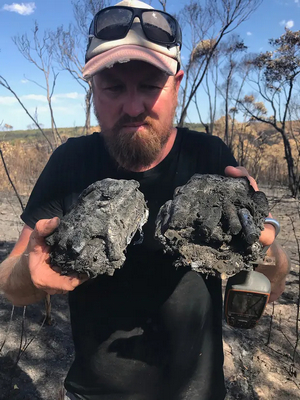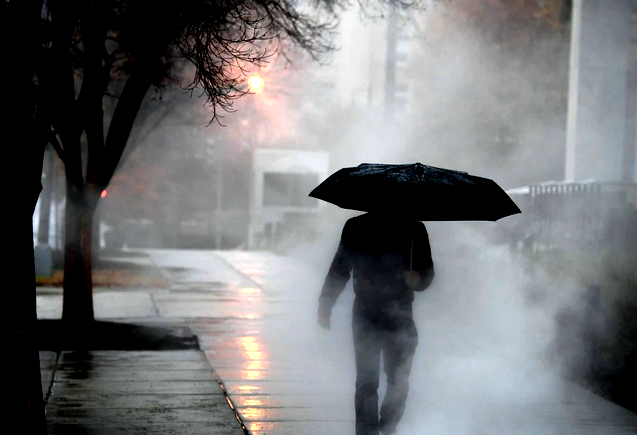With our south-east coast aflame, our dead uncounted, our holiday beaches rendered into evacuation zones; with our queues for water, fuel, food and for simple escape, Australia now has the world’s attention.
In international eyes, our leaders have been found wanting not only in planning for such a catastrophe, and not just for the failure of some to match the tenacious heroism of our volunteers, but for their refusal to accept the catastrophic reality of climate change and its link with the burning of coal.
Scott Morrison has been abused by community members on a visit to the bushfire ravaged town of Cobargo.
A headline in The Washington Post on Friday morning Australian time bluntly captured Scott Morrison’s humiliation upon visiting Cobargo hours earlier: “Australia’s Prime Minister visited families devastated by the wildfires. It did not go well.”
In the same paper, a caption on the video footage of volunteer firefighters declining to shake the PM’s hand read: “Australians resist, shun Prime Minister amid deadly wildfires.”
At the very same time, The New York Times was reporting that “the fires have fueled anger at Australia’s Prime Minister, Scott Morrison, who has downplayed the role of global warming, opposed measures to combat climate change and rejected additional funding for firefighters. After widespread ridicule, last month he cut short a vacation during the crisis, a trip that critics said showed he did not take the disaster seriously enough.”
It quoted the angry Cobargo resident who told him in front of TV cameras on Thursday, in what will surely be some of the best remembered footage of Morrison’s prime ministership: “You won’t be getting any votes down here buddy. You’re out son.”
The German broadcaster DW noted that locals had called Morrison an “idiot” and described the criticism he had received for his Christmas holiday to Hawaii.
In America, CNN carried a report that said: “Experts say climate change has worsened the scale and impact of the fires, and many have accused the Morrison administration of doing little to address the climate crisis. In December, a woman dumped the remnants of her fire-ravaged home in front of the Australian Parliament, accusing Morrison and lawmakers of failing to act.”
When he saw the footage of Morrison’s reception in Cobargo, English broadcaster Piers Morgan, normally a reliable friend to populist conservatives, tweeted “he got what he deserved ... absolutely unconscionable for a Prime Minister to holiday in Hawaii as his nation burns”.
By now, NSW Emergency Services Minister David Elliott, at the time of writing still declining to take calls as he returns from a European jaunt that began after the deaths of NSW volunteer firefighters, must feel some relief that he has no international profile.
 |
| Illustration: John Shakespeare |
On December 23, Al Jazeera reported: "Australia's government is resisting growing calls for a more ambitious response to climate change, even as the country battles devastating bushfires triggered by record temperatures that have sent air pollution to critical levels."
It noted that Australia “releases 1.3 per cent of the world's greenhouse gases ... its population accounts for 0.3 per cent of the world's inhabitants”.
In a feature published just after Christmas, The Washington Post charted the terrible damage already wrought upon Australia’s environment by climate change. “On land, Australia's rising heat is ‘apocalyptic'. In the ocean it’s worse,” read the headline. It recounted how flying foxes and possums were falling dead out of trees in heat waves, how the giant kelp forests of Tasmania had already been obliterated. “This is happening even though average atmospheric temperatures in Australia have yet to increase by 2 degrees Celsius,” it reported.
Australia also captured global attention during the most recent United Nations climate change talks in Madrid in early December, known as COP25, which were widely seen as a dismal failure in the face of existential global threat.
In this international ring, Australia punched well above its weight, identified as one of the nations most responsible for wrecking any chance of securing a meaningful outcome alongside giants like Brazil and the United States.
In a piece entitled “The winners were the brakemen”, Die Welt explained to German readers how Australia had insisted on double-counting old emissions cuts to meet new commitments.
"Countries such as Australia, Brazil and the USA have blocked and delayed the UN climate protection process in Madrid. The growing will in many countries to stop global warming with decisive action could not prevail here because of the unanimity principle,” Michael Schafer, head of Climate and Energy at the environmental organisation WWF Germany, told German broadcaster Welt. Reimund Schwarze, environmental economist at the Helmholtz Centre for Environmental Research, spoke of the talks as a "long tragedy".
 |
| Prime Minister Scott Morrison's approach to climate change has been called lethargic. Credit: AAP |
“Australia played its part in this failure with proposals that would have rendered any agreement practically useless,” wrote James Dyke of the University of Exeter in The Independent newspaper.
“But its continual production of coal is more destabilising. It's no surprise that coal mining corporations want to continue coal mining. But the fact that certain Australian political parties and sections of the media strongly promote coal should be a source of immense shame. The greatest gift they could give to Australians and the rest of the world would be to radically rethink their ideological attachment to this fossil fuel.”
The diplomatic cost of Australia’s determination to defend its coal industry in the face global efforts to cut greenhouse emissions is significant, broad and so far incalculable, says Herve Lemahieu, the director of the Lowy Institute's Asian Power and Diplomacy Program, an ongoing project that measures shifting national power dynamics across our region.
Speaking from London, he said that as a result of coverage of Australia’s performance in Madrid and of the bushfires Australia is now seen in a different, darker light across Europe. Where once it existed in the popular imagination as a place of almost pristine natural beauty, it is now viewed as the Western nation most ravaged by climate change. It’s reputation as a global citizen has been irrevocably tarnished.
 |
| NSW RFS firefighters work through the night. Credit: Kate Geraghty |
“The global media has made a link between Australia’s protection of its coal industry and its climate policy. The cat is out of the bag,” says Lemahieu.
The impact of this new understanding of Australia will not only damage our effectiveness in future climate negotiations, it will hurt all Australian diplomatic efforts, he says.
“Australia is currently negotiating a free trade agreement with the EU,” he explains. “That will have to be ratified by the EU parliament and by some EU nations. Support for [a free trade agreement with Australia] is going to face a democratic test among populations that have made that link.”
Tim Buckley, the director of Energy Finance Studies at the Institute for Energy Economics and Financial Analysis, says his frustration at the government’s intransigent defence of increasingly technologically obsolete thermal coal (coal burnt for energy rather than steel manufacturing) at the cost of effective climate change policy and international reputation is compounded by his view that the industry has commenced its drawn-out death throes, sustained by political muscle rather than economic reality.
Coal power's defenders point to a recent uptick in imports to China and India and the long-term potential of customers such as Bangladesh, Pakistan and Vietnam. Buckley concedes China and India will continue to buy Australian coal in the short term as they seek to maintain economic growth at up to 6 or 7 per cent annually.
But both have made clear their intention to first transition to domestic coal as fast as they can build the necessary infrastructure while concurrently decarbonising their economies in line with the rest of the world. A Bloomberg analysis published on December 23 predicted “misery” for Australian coal exporters as China cut imports.
He says the coal-fired power generation of those other nations mentioned as long-term customers is wholly dependent on subsidies from nations financing and constructing their coal sectors – mainly China, South Korea and Japan. Both South Korea and Japan, he says, are already showing signs that they want to abandon the sector.
Buckley argues that the thermal coal industry’s tipping point has already passed, missed by its champions in Morrison’s government but already factored in by global money markets.
US coal stocks dropped an average 50 per cent in 2019 while Exxon remained flat in a US equity market that rose 28 per cent overall, meanwhile the share price of the world’s largest investor in renewables, the US utility Nextera Energy, leapt by 42 per cent. Banks and insurers around the world – among them ANZ, Credit Suisse and Goldman Sachs – are increasing restrictions on their dealings with thermal coal and coal-fired power generation operations.
Divestment from fossil fuel is being turbo-charged by the rise of institutional shareholder activism. The Institutional Investors Group on Climate Change now has a combined $24 trillion in assets under management, and is developing “a practical and useable framework for investors to be able to understand what it would mean for a pension fund to align with the goals of the Paris Agreement.” In other words, it is developing a practical guide for its members to use in dumping coal.
Later this month, Morrison had planned to India in order to help sell more coal. That trip might now not go ahead. Buckley reckons he would have received a polite welcome, not least because India is keen on Australian LNG. He might have even helped sell more coal for a few more years.
But it would be delusional, says Buckley, to believe that Australia will get to choose how and when it transitions from coal. The rest of the world will make that decision for us, and it could do so suddenly.
Tipping points can be easy to miss in financial markets, says Buckley. In part, this is because they are by nature sudden and dramatic. In part, it is because it is so tempting to keep basing forecasts on historical trends.
“You can get away with that for years,” he says, “until it makes you look like a fool.”
This summer, Australia has been clobbered by the immediate practical reality of climate change. A similarly violent collision with economic and political realities now faces leaders of both parties and their friends in the coal industry.
Links
- Bushfire victim slams Scott Morrison for walking away
- 'Morrison is losing skin': PM too passive in the face of national crisis
- 'Justified in feeling angry': Premier stands by Constance after he lashes Morrison
- Fivefold increase in funding for hazard reduction burns needed, experts warn
- Global Apathy Toward the Fires in Australia Is a Scary Portent for the Future
- Australia’s bushfires intensify its debate about climate change
- On land, Australia’s rising heat is ‘apocalyptic.’ In the ocean, it’s worse.
- Misery Looms Over Top Coal Shippers as China to Buy Less in 2020






